|
|
|
Sort Order |
|
|
|
Items / Page
|
|
|
|
|
|
|
| Srl | Item |
| 1 |
ID:
051966
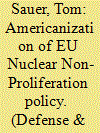

|
|
|
| 2 |
ID:
052472
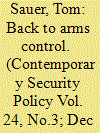

|
|
|
|
|
| Publication |
Dec 2003.
|
| Summary/Abstract |
Since the end of the 1990s, the United States is spending an enormous amount of time, money and energy in developing a workable missile defence system. The Bush administration plans to deploy a couple of missile interceptors in Alaska and California before September 2004. This article assesses different US missile defence scenarios, using four criteria: technological feasibility, cost, threat perception, and strategic stability. Based on these four criteria, we conclude that only a limited US NMD system that is not easily expandable will be acceptable for the other global actors, including Russia, China and Europe. It also requires a multilateral anti-ballistic missile treaty that sets limits to missile defence.
|
|
|
|
|
|
|
|
|
|
|
|
|
|
|
|
| 3 |
ID:
127828
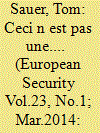

|
|
|
|
|
| Publication |
2014.
|
| Summary/Abstract |
There is hardly anybody in Belgium who publicly defends the continued deployment of US tactical nuclear weapons on Belgian territory. The longer these weapons stay, the more the existing nuclear weapons policy and by extension North Atlantic Treaty Organization itself will be regarded as illegitimate. While one should not expect massive demonstrations similar to that at the beginning of the 1980s, the pressure to protest increases. By describing the different societal and political actors in Belgium and their respective views on the possible withdrawal of US tactical nuclear weapons, this article tries to explain the gap between policymakers and citizens on this issue. The main explanatory variables are a low-profile diplomatic culture and the lack of a strong link between the anti-nuclear movement and the political parties in power, resulting in the absence of political leaders at the governmental level, who clearly speak out in favor of withdrawal.
|
|
|
|
|
|
|
|
|
|
|
|
|
|
|
|
| 4 |
ID:
078987


|
|
|
|
|
| Publication |
2007.
|
| Summary/Abstract |
The European Union has been the main international actor trying to contain the Iranian nuclear programme. In 2003, for the first time ever, the EU-3 adopted a coercive diplomatic approach vis-à-vis Iran. The current article begins with an analysis of the concept of coercive diplomacy before applying it to the Iranian case. In so doing, the article aims to make an interim assessment of the European (EU-3) effort.
|
|
|
|
|
|
|
|
|
|
|
|
|
|
|
|
| 5 |
ID:
137508
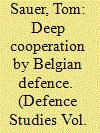

|
|
|
|
|
| Summary/Abstract |
Despite tight budgetary constraints, the number of military interventions in which Belgium participated is substantial. The Belgian air force and navy were able to retain their basic war fighting capabilities after the Cold War. The land forces lost and are losing capabilities because of a lack of strategic anchoring. The most important Belgian contribution to international and European defence thinking has to be found in the innovative approach with respect to Belgian–Dutch naval cooperation. The latter could be an example for Europeanizing and generating the use of military capabilities in order to make the EU a strategic actor in the multipolar world.
|
|
|
|
|
|
|
|
|
|
|
|
|
|
|
|
| 6 |
ID:
179827
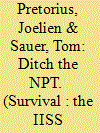

|
|
|
|
|
| Summary/Abstract |
Without the Nuclear Non-Proliferation Treaty, nuclear-armed states and their allies could no longer rely on their skewed interpretation of it to legitimise continued possession of nuclear weapons.
|
|
|
|
|
|
|
|
|
|
|
|
|
|
|
|
| 7 |
ID:
146717
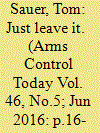

|
|
|
|
|
| Contents |
The biennical NATO summit in Poland next month comes at a time of deeply strained relations between NATO and Russia. The Russian occupation of Crimea is a direct challenge to internationally agreed principles.
|
|
|
|
|
|
|
|
|
|
|
|
|
|
|
|
| 8 |
ID:
054408


|
|
|
|
|
| Publication |
Hampshire, macmillan Press, 1998.
|
| Description |
xv, 146p.
|
| Standard Number |
033371685
|
|
|
|
|
|
|
|
|
|
|
|
Copies: C:1/I:0,R:0,Q:0
Circulation
| Accession# | Call# | Current Location | Status | Policy | Location |
| 040212 | 355.825119/SAU 040212 | Main | On Shelf | General | |
|
|
|
|
| 9 |
ID:
158017
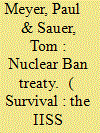

|
|
|
|
|
| Summary/Abstract |
Future historians may record summer 2017 as the beginning of the end of the nuclear age. On 7 July 2017, 122 states adopted the text of a legally binding international treaty that provides for a comprehensive ban on nuclear weapons (or ‘ban treaty’).1 The treaty was opened for signature on 20 September 2017, and at the time of writing, 56 states had signed and five had ratified.
|
|
|
|
|
|
|
|
|
|
|
|
|
|
|
|
| 10 |
ID:
117862


|
|
|
|
|
| Publication |
2012.
|
| Summary/Abstract |
The idea of nuclear elimination is becoming more popular. At the same time, missile defence is being built. The aim of this article is to link the two phenomena: does Global Zero require effective missile defence, or will missile defence hamper the road towards nuclear elimination? First, I will examine how proponents of the recent move towards nuclear elimination regard missile defence: are they in favour or against? This descriptive portion of the article is followed by a personal evaluation based on the literature. Assuming that nuclear elimination becomes a priority in order to win the fight against nuclear proliferation and nuclear terrorism, and assuming that missile defence will not become reliable under real circumstances, then the best option seems to be zero offensive and zero defensive ballistic missiles. Second best would be to limit the existing missile defence capabilities to theatre missile defence, excluding those theatre missile defence systems (like advanced SM-3 missiles on Aegis ships) that can easily be plugged together to form a strategic missile defence capability.
|
|
|
|
|
|
|
|
|
|
|
|
|
|
|
|
| 11 |
ID:
134606


|
|
|
|
|
| Summary/Abstract |
The traditional arms control approach is slow in dismantling nuclear arsenals. It is also a state-centered approach, and does not enthuse public opinion as it is rather technical and complex. The recent interest in the so-called humanitarian approach of nuclear disarmament can be explained by a growing frustration with traditional arms control. The humanitarian approach points to the consequences of the use of nuclear weapons for individual human beings, and recommends forbidding nuclear weapons. The step-by-step approach is replaced by a principled approach, which holds that nuclear weapons are too destructive to be used, just like chemical and biological weapons. A ban on nuclear weapons will turn the tables. The burden of proof will shift from the non-nuclear weapon states to the nuclear weapon states. Those nuclear weapon states that are not eager to eliminate their nuclear weapons will come under growing pressure from worldwide public opinion as well as their own public opinion. It is this stigmatizing effect of nuclear weapons as inhumane and therefore unusable that may bring all states to pursue Global Zero.
|
|
|
|
|
|
|
|
|
|
|
|
|
|
|
|
| 12 |
ID:
167794
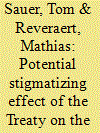

|
|
|
|
|
| Summary/Abstract |
On July 7, 2017, seventy-two years after the start of the nuclear era, 122 states concluded the Treaty on the Prohibition of Nuclear Weapons (TPNW, or “ban treaty”). The treaty forbids the development, production, acquisition, possession, transfer, testing, use, and threat of use of nuclear weapons. Advocates of the TPNW understand that it will not automatically lead to a world without nuclear weapons. The treaty’s main goal is to stimulate a societal and political debate inside the nuclear-armed states and their allies by strengthening the antinuclear norm and by stigmatizing nuclear weapons and their possessors. This article assesses to what extent this process of stigmatization might take place. It starts by elaborating on the concepts of stigma and stigmatization. It then matches the concept of stigma with nuclear weapons, and with the humanitarian initiative behind the momentum that led to the TPNW. The article concludes by looking to different stigma-management approaches that can be used by the nuclear-armed states and their allies.
|
|
|
|
|
|
|
|
|
|
|
|
|
|
|
|
| 13 |
ID:
091777
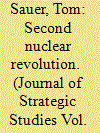

|
|
|
|
|
| Publication |
2009.
|
| Summary/Abstract |
This article predicts that the nuclear weapon states may opt sooner for nuclear elimination than generally expected. This delegitimation of nuclear weapons is due to five factors whose importance has grown since the mid-1990s: nuclear proliferation, the risk of nuclear terrorism, the nuclear taboo, missile defence, and the increased importance of international law. The article starts with categorizing nuclear weapons policies: nuclear primacy, maximum deterrence, minimum deterrence, existential deterrence, and post-existential deterrence. The nuclear weapon states will probably shift their policies from nuclear primacy (US), maximum deterrence (Russia), minimum or existential deterrence (UK, France, Israel, China, India, Pakistan, North Korea) to post-existential deterrence (or elimination), taking one step at a time.
|
|
|
|
|
|
|
|
|
|
|
|
|
|
|
|
| 14 |
ID:
085664


|
|
|
|
|
| Publication |
2008.
|
| Summary/Abstract |
In 2003, the EU was hopeful to convince Iran to give up its nuclear programme. Five years later, most signals point to an accelerated nuclear programme in Iran. This article first aims to sketch an overview of the EU efforts, and secondly to make an interim assessment of the effectiveness of the EU's approach vis- -vis Iran. While the final assessment may be different, the current evaluation is disappointing from the point of view of the EU. The Iranian case does not enhance the EU's strategic reputation in the world.
|
|
|
|
|
|
|
|
|
|
|
|
|
|
|
|
| 15 |
ID:
187212
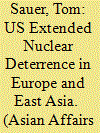

|
|
|
|
|
| Summary/Abstract |
Analysing the alliance system in Europe and Asia in a comparative perspective also demands having a look at the specific role of nuclear weapons in the defence doctrines, and more in particular the role of US extended nuclear deterrence. The main question that this article wants to resolve is: what are the similarities and differences in both regions with respect to extended nuclear deterrence? This (comparative) descriptive analysis is complimented with the following predictive question: which trends in both regions make it likely that extended nuclear deterrence will be strengthened, weakened, or maybe completely disappear? To answer these questions, the following structure is followed: first, the concept of extended nuclear deterrence will be described; next, this concept of extended nuclear deterrence will be applied to Europe and Asia; lastly, three trends that have an impact on the current debate on extended nuclear deterrence are analysed: 1) the deteriorating security situation; 2) the changing balance of power, and more in particular the relative decline of the US and the rise of China; and 3) the evolving nuclear arms control and disarmament regime, including the arrival of the Treaty on the Prohibition of Nuclear Weapons (TPNW).
|
|
|
|
|
|
|
|
|
|
|
|
|
|
|
|
| 16 |
ID:
112424


|
|
|
|
|
| Publication |
2012.
|
| Summary/Abstract |
The article describes how over the past two decades the role of US forward-deployed tactical nuclear weapons has gradually declined, and explains the logic behind their decreased importance. The main arguments in favor of the continuation of the process of their removal from Europe, until they have been entirely eliminated over the next couple of years, are listed, and the reasons for NATO's desire to nevertheless prolong its reliance on these weapons are investigated. Further, the political feasibility of their complete withdrawal and the political practicalities of such a withdrawal are analyzed.
|
|
|
|
|
|
|
|
|
|
|
|
|
|
|
|
| 17 |
ID:
185998
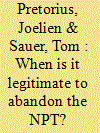

|
|
|
|
|
| Summary/Abstract |
Treaties can be denounced and withdrawn from unilaterally and collectively. We ask when it would be legitimate to abandon the NPT, a treaty that 50 years ago committed states to nuclear non-proliferation and disarmament, but still has not delivered on the latter. The end of the NPT is a taboo subject in the arms control community that sees it as the cornerstone of the nuclear order. We draw on literature on the legitimacy of and exit from international institutions. We especially explore the political substance of the discontent that the non-nuclear weapons states have expressed in and outside the NPT forum. Exiting the NPT can legitimately be used as a political tool to challenge the current status quo where five states claim a right to possess nuclear weapons based on the NPT, and to achieve a nuclear order where nuclear weapons are illegal for all.
|
|
|
|
|
|
|
|
|
|
|
|
|
|
|
|
|
|
|
|
|